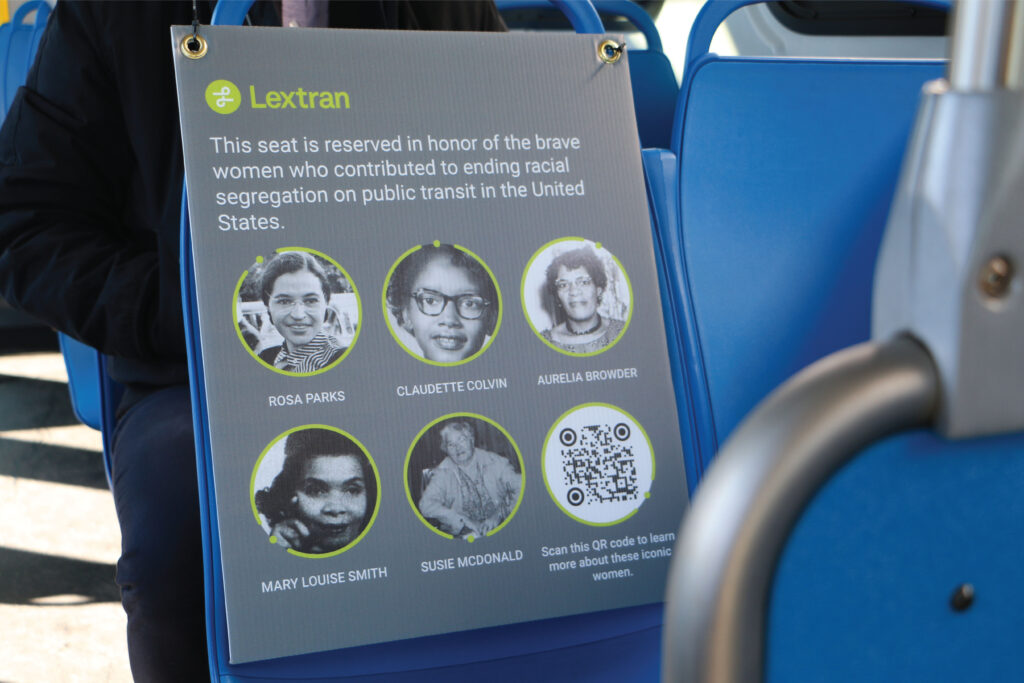February 1, 2022

Lextran is continuing the tradition of commemorating civil rights icons by reserving a seat on each bus in honor of Rosa Parks and the women involved in the Browder v. Gayle case.
The reserved seats feature a poster with photos of Rosa Parks, Claudette Colvin, Aurelia Browder, Mary Louise Smith, and Susie McDonald. The posters will be on the buses starting Tuesday, February 1, to mark the beginning of Black History Month, and remain through Monday, February 28.
In February 2019, Lextran began reserving a seat onboard each bus in honor of Rosa Parks. A couple of years later, in February 2021, Lextran added Colvin, Browder, Smith, and McDonald in posters with Parks. While Parks is a notable civil rights icon, the inclusion of the other four women paints a broader picture of the impact the civil rights movement had on public transit.
Parks, Colvin, Browder, Smith, and McDonald’s History and Influence on Public Transit
On March 2, 1955, at the age of 15, Claudette Colvin was on her way home from high school in Montgomery, Alabama when she was told to move to the back of the bus to make room for white passengers. She refused, leading to her arrest. Despite being the first person to be arrested for refusing to move seats, civil rights leaders decided she was not the best suited to be the symbol or icon behind the movement to end segregation on public transit because of her age and the fact she was pregnant outside of marriage.
One month after Colvin’s arrest, Aurelia Browder was arrested in April 1955 for sitting in the white section of the Montgomery city bus. She was the lead plaintiff in the Browder v. Gayle Case. Following her involvement in the case, she continued to be an active member of the National Association for the Advancement of Colored People (NAACP), the Montgomery Improvement Association (MIA), and the Southern Christian Leadership Conference (SCLC).
In October 1955, Mary Louise Smith and Susie McDonald refused to give up their seats on buses in Montgomery and were both arrested for breaking the segregation laws. Smith and McDonald were not selected as the figure to base the class action lawsuit or the bus boycott due to their respective ages. Smith was 18 at the time of her arrest and McDonald was in her 70s.
In December 1955, Rosa Parks famously refused to give up her seat to a white man on her commute home. The building frustrations around segregated seating led to the Montgomery Bus Boycott immediately following Parks’ arrest.
On February 1, 1956, civil rights attorney, Fred Gray, filed the Browder v. Gayle case in the U.S. District Court with Browder, Colvin, Smith, and McDonald as the plaintiffs. The Federal District Court for the Middle District of Alabama was reviewing the Browder v. Gayle case as the bus boycott gained national attention. Finally, on June 5, 1956, the court ruled that Alabama and Montgomery bus segregation laws were unconstitutional. The state and city appealed to the US Supreme Court, which upheld the initial ruling.
On December 17, 1956, the state was denied a petition for a rehearing. Three days later, the ruling was implemented when Montgomery’s mayor, W.A. Gayle, was given official written notice by federal marshals lawfully ending segregation on public transit in the United States.
Additional Resources
You can learn more about these civil rights icons and African American history by visiting the Lexington Public Library. A catalog of books and references is available online on the library’s website.
